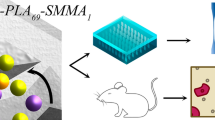Abstract
This study focused on the synthesis, characterization and cytocompatibility of a biodegradable polymer by the cross-linking from poly(ethylene glycol-co-lactide) dimethacrylate (PLEGDMA), polyethylene glycol diacrylate (PEGDA) and N-isopropylacrylamide, where PLEGDMA was synthesized by ring-opening oligomerization of poly(ethylene glycol) with different molecular weights (Mn = 400, 600, 1000, 2000 Da) and l-lactide using low toxic iron(III) acetylacetonate (Fe(acac)3) as the catalyst and subsequently being terminated with dimethacrylate. The product, PLEGDMA, was analyzed to confirm its chemistry using FTIR spectroscopy, 1H NMR spectra and gel permeation chromatography etc. The thermodynamic properties, mechanical behaviors, surface hydrophilicity, degradability and cytotoxicity of the cross-linked product were evaluated by differential scanning calorimetry, tensile tests, contact angle measurements and cell cultures. The effects of reaction variables such as PEGDA content and reactants ratio were optimized to achieve a material with low glass transition temperature (Tg), high wettability and preferable mechanical characteristics. Using a tubular mould which has been patented in our group, a tubular scaffold with predetermined dimension and pattern was fabricated, which aims at guiding the growth and phenotype regulation of esophageal primary cells like fibroblast and smooth muscle cell towards fabricating tissue engineered esophagus in future.








Similar content being viewed by others
References
Zhou J, Han S, Dou Y, Lu J, Wang C, He H, Li X, Zhang J. Nanostructured poly(l-lactide) matrix as novel platform for drug delivery. Int J Pharm. 2013;448:175–88.
Zhao JH, Luo CH, Han WQ, Tu M, Zeng R, Cha ZG, Zhou CR. Fabrication and properties of poly(l-lactide)/hydroxyapatite/chitosan fiber ternary composite scaffolds for bone tissue engineering. J Polymer Eng. 2012;32:283–9.
Hu Y, Hu YS, Topolkaraev V, Hiltner A, Baer E. Aging of poly(lactide)/poly(ethylene glycol) blends. Part 2. Poly(lactide) with high stereoregularity. Polymer. 2003;44:5711–20.
Collins MN, Birkinshaw C. Hyaluronic acid based scaffolds for tissue engineering—a review. Carbohydr Polym. 2013;92:1262–79.
Hu Y, Hu YS, Topolkaraev V, Hiltner A, Baer E. Crystallization and phase separation in blends of high stereoregular poly(lactide) with poly(ethylene glycol). Polymer. 2003;44:5681–9.
Hu Y, Rogunova M, Topolkaraev V, Hiltner A, Baer E. Aging of poly(lactide)/poly(ethylene glycol) blends. Part 1. Poly(lactide) with low stereoregularity. Polymer. 2003;44:5701–10.
Kadajji VG, Betageri G. Water soluble polymers for pharmaceutical applications. Polymers. 2011;3:1972–2009.
Wu CJ, Wilker JJ, Schmidt G. Robust and adhesive hydrogels from cross-linked poly(ethylene glycol) and silicate for biomedical use. Macromol Biosci. 2013;13(1):59–66.
Sousa-Herves A, Riguera R, Fernandez-Megia E. PEG-dendritic block copolymers for biomedical applications. New J Chem. 2012;36:205–10.
Shoichet MS. Polymer scaffolds for biomaterials applications. Macromolecules. 2010;43:581–91.
Sebra RP, Reddy SK, Masters KS, Bowman CN, Anseth KS. Controlled polymerization chemistry to graft architectures that influence cell–material interactions. Acta Biomater. 2007;3:151–61.
Mero A, Schiavon O, Pasut G, Veronese EE, Ferruti P. A biodegradable polymeric carrier based on PEG for drug delivery. J Bioact Compat Polym. 2009;24:220–34.
Spasova M, Stoilova O, Manolova N, Rashkov I, Altankov G. Preparation of PLLA/PEG nanofibers by electrospinning and potential applications. J Bioact Compat Polym. 2007;22:62–76.
Lee SH, Miller JS, Moon JJ, West JL. Proteolytically degradable hydrogels with a fluorogenic substrate for studies of cellular proteolytic activity and migration. Biotechnol Prog. 2005;21:1736–41.
Boua-In K, Chaiyut N, Ksapabutr B. Preparation of polylactide by ring-opening polymerisation of lactide. Optoelectron Adv Mater-Rapid Commun. 2010;4:1404–7.
Ouyang CP, Ma GL, Zhao SX, Wang L, Wu LP, Wang Y, Song CX, Zhang ZP. Preparation and characterization of the molecular weight controllable poly(lactide-co-glycolide). Polym Bull. 2012;67(5):793–803.
Kowalski A, Duda A, Penczek S. Mechanism of cyclic ester polymerization initiated with Tin(II) octoate.2. macromolecules fitted with Tin(II) alkoxide species observed directly in MALDI-TOF spectra. Macromolecules. 2000;33:689–95.
Kricheldorf HR, Kreiser-Saunders I, Stricker A. Polylactones 48. SnOct2-initiated polymerization of lactide: a mechanistic study. Macromolecules. 2000;33:702–9.
Lei YN, Zhu YB, Chen L, Hou LX. Polymerization of aliphatic cyclic ester using iron compounds as catalysts. J Funct Polym. 2011;24:297–302.
Menzies KL, Jones L. The impact of contact angle on the biocompatibility of biomaterials. Optom Vis Sci. 2010;87(6):387–99.
Wang YQ, Jiao YP, Cai JY, Zhou CR. Polym. changes in surface morphologe of poly(l-lactic acid) observed by atomic force microscopy and effect on cell adhesion. Mater Sci Eng. 2005;21:181–8.
Gong CF, Hou L, Zhu YB, Lv JJ, Liu YX, Luo L. In vitro constitution of esophageal muscle tissue with endocyclic and exo- longitudinal patterns. ACS Appl Mater Interfaces. 2013;5:6549–655.
Shen QX, Shi PN, Gao MN, Yu XC, Liu YX, Luo L, Zhu YB. Progress on materials and scaffold fabrications applied to esophageal tissue engineering. Mater Sci Eng C. 2013;33:1860–6.
Höglund A, Hakkarainen M, Albertsson AC. Migration and hydrolysis of hydrophobic polylactide plasticizer. Biomacromolecules. 2010;11:277–83.
Bergsma JE, Bruijn WC, Rozema FR, Bos RM, Boering G. Late degradation tissue response to poly(l-lactide) bone plates and screws. Biomaterials. 1995;16:25–31.
Tunc DC, Jadhav B. Development of absorbable, ultra high strength poly(lactides). In: Gebelein CG, Dunn RL, editors. Progress in biomedical polymers. New York: Springer; 1990. p. 239–48.
Shen JY, He B, Chan-Park MB, Zhu AP, Zhu X, Beuerman RW. Three-dimensional microchannels in biodegradable polymeric films for control orientation and phenotype of vascular smooth muscle cells. Tissue Eng. 2006;12:2229–40.
Stegemann JP, Nerem RM. Phenotype modulation in vascular tissue engineering using biochemical and mechanical stimulation. Ann Biomed Eng. 2003;31:391–402.
Acknowledgments
Financial supports by the National Science Foundation (81171476), Natural Science Funds and NSF for Distinguished Youth team of Zhejiang Province (LY12B01005, R2101166) and Scientific Innovation Team Project of Ningbo (No. 2011B82014), China, are gratefully acknowledged. This work was also sponsored by K.C. Wang Magna Fund of Ningbo University.
Author information
Authors and Affiliations
Corresponding authors
Rights and permissions
About this article
Cite this article
Lei, YN., Zhu, YB., Gong, CF. et al. Synthesis, characterization and cytocompatibility of a degradable polymer using ferric catalyst for esophageal tissue engineering. J Mater Sci: Mater Med 25, 273–282 (2014). https://doi.org/10.1007/s10856-013-5068-1
Received:
Accepted:
Published:
Issue Date:
DOI: https://doi.org/10.1007/s10856-013-5068-1




